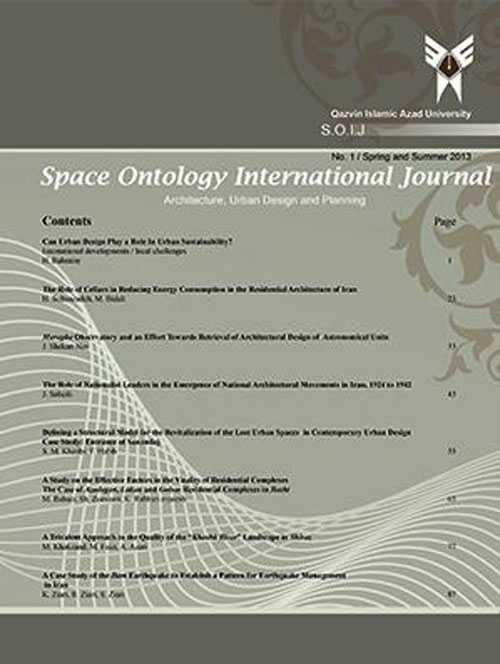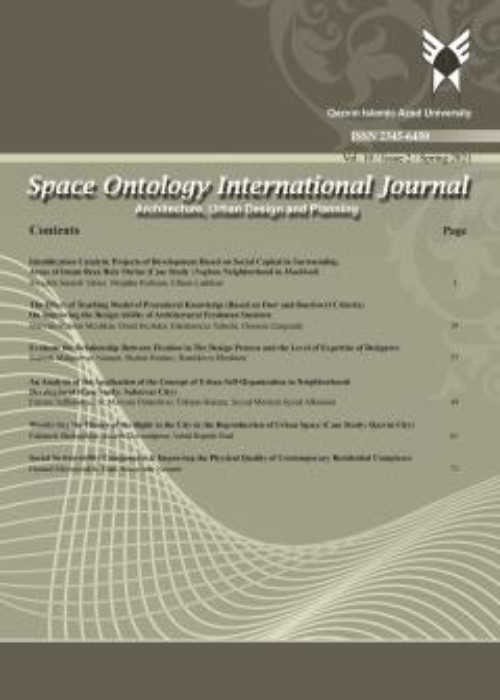فهرست مطالب

Space Ontology International Journal
Volume:11 Issue: 2, Spring 2022
- تاریخ انتشار: 1401/06/13
- تعداد عناوین: 6
-
-
Pages 1-17
The historical texture of the city reflects the identity of the city and has hidden values within it which need to be identified and used to restore the context. These values can be named as social capital to preserve the old textures. Urban catalyst project is suggested as one of the late approaches in the process of urban regeneration. This use elements and values in the Current Situation to define stimulants for changes in the Context. Urban catalyst involving number of projects that lead to the development and its effect on further progression. The main purpose of this research is to build a robust and participatory society based on the relationship between social capital and urban catalyst project. In fact this goal focuses on social and public aspects beside physical and economic ones. For examining relationships between social capital and development catalyst project, Noghan Religious District in Mashhad, one of the oldest settlements adjacent to the Razavi shrine, has been evaluated. As a result, Combined research method has been used. The relationship between these two variables have been surveyed through field research and questionnaire distribution in society which includes people and experts and the structural equation method(SEM) used to examine the relationship between variables. According to the findings, the potentials of society in the form of social capital can provide ground for the development catalyst project in the texture. Therefore, development catalyst project has a significant correlation with social capital to improve the context.
Keywords: Historical Texture, Urban catalyst projects, Social capital, Correlation, SEM -
Pages 19-35
The aim of this study was to implement the teaching model of procedural knowledge in teaching basic design studio courses and to investigate the effect of this teaching model on improving the design ability of freshman students by evaluating their activities as a test of this method. Architectural basic design (I) lesson has been considered as a case study in this research. This teaching model is based on the theoretical foundations of procedural knowledge and the criteria that determine a teaching model in terms of "Oser and Baeriswyl". The method of the present study was quasi-experimental with a pre-test, post-test, follow-up test design with a control group. The statistical population included first year undergraduate students of architectural engineering in universities of Hamadan province. Among them, 30 students of architectural basic design (I) lesson of Islamic Azad University, Hamadan Branch were selected as a sample by available sampling method, but were assigned randomly. The data collection tool was a researcher-made test to measure students' performance, which was approved by experts. Data analysis method using descriptive statistics (mean, variance, standard deviation, etc.), inferential tests (covariance and its assumptions) and t-test using SPSS software (2021) version. Findings showed that teaching based on teaching model of procedural knowledge can through increasing learning motivation, recall past learning and create meaningful learning, facilitate learning flow, increase cognitive involvement and learning stability, develop design schematas and improve problem solving skills, Improves the design ability of architectural freshman students in the design studio of architectural basic design (I).
Keywords: Design ability, Procedural Knowledge, Declarative knowledge, Teaching Model, Architectural basic design (I) -
Pages 37-48
In the context of creativity in design, much research has been done with an endeavor to discover the factors advocating creativity in design. Though, not much effort has been put in identifying of the factors disrupting creativity. One phenomenon that acts as an obstacle to creativity in design, or detracts from it, is the phenomenon of fixation. The term “design fixation” is often used interchangeably to refer to situations where designers limit their creative output because of an overreliance on features of preexisting designs, or more generally, an overreliance on a specific body of knowledge directly associated with a problem. It is understood as the inability to solve design problems by employing a typical or familiar method, ignoring new or better ones. In this research, an attempt has been made to investigate the factors that create fixation in design by examining how the previous knowledge of designers affects design. This way, a structure was presented to better understand the factors of fixation in the stages of the design process. Then it was explored what the differences and similarities in designers with different levels of expertise are. Finally, the formation of fixation in the design process stages, under the influence of the designers expertise level as an intervening variable, was explained. And so, the designers will be able to recognize the causes of their fixation and prevent fixation in design or at least reduce its amount. Also, design teachers, with awareness of these causes, will be able to guide students to stay away from this phenomenon.
Keywords: Fixation, Design process, precedent knowledge, level of expertise -
Pages 49-59
Although citizen participation in the neighborhood-centered approach is a key issue, there is ample evidence that the implementation of participatory approaches has led to disappointing results. According to researchers, the concept of urban self-organization can provide a way out of this dilemma for planners. Despite the importance of this issue, so far, no research has been done on how to use this concept in the process of planning and development of neighborhoods and cities in Iran. The present study tries to examine and analyze how to apply the concept of urban self-organization in the development of neighborhoods in Iran. A case study of this research is Sabzevar city and the research method is multi-ground theory. The analysis of the collected data led to the extraction of 547 primary codes, 77 concepts, and 31 categories. Finally, the abstracted categories and the relationships between them were drawn and presented in a model. According to the findings of this study, the pattern of self-organized participation of citizens in neighborhood development is a transparent, borderless, sustainable, and technology-based network that connects all actors involved in neighborhood development. This pattern brings about the integrated development of neighborhoods and through very soft and gradual changes, creates huge changes in the cities.
Keywords: Multi grounded theory, Neighborhoods Development, Sabzevar, Urban Self-Organization -
Pages 61-72
It is possible to measure the realization of the right to the city as a demand related to the right to use urban space relying on the concept of perceived space, so It can also be said that attention to this subject can deal with the inefficiencies of urban spaces is important. The present study was an applied developmental type in terms of purpose and a survey in terms of method. A quantitative research method with a questionnaire, after categorizing the components of urban space desirability and the right to the city with a sample size of 390 citizens of Qazvin, sample selection was performed by combining proportional stratified- disproportional cluster sampling method. Then, using R 3.3.0 software and Kruskal-Wallis test statistical technique to determine the desirability of urban spaces by districts and also Kolmogorov-Smirnov test to assess the effect of each component on the desirability of urban space and finally, Spearman correlation test, shows that the desirability of urban spaces has a direct effect on the satisfaction of the right to the city. The obtained statistics show an average relationship between the two topics. In other words, increasing the desirability of urban space will significantly increase satisfaction with the right to the city. One of the main requirements for establishing this relationship correctly is the change in the occupation of urban spaces. Finally, the most distinction between the components of urban space desirability and residential district, the perceptual component of urban space desirability was obtained.
Keywords: Desirability of Urban Spaces, Realization of the Right to the City, Right to the inhabit, Right to the Participation -
Pages 73-86
The paradigm of social sustainability in contemporary literature has always been widely proposed to solve the problems and inefficiencies of the physical environment in various scales of the urban space. Hence, addressing the concept of social sustainability on a micro-scale, such as residential complexes that have been less discussed, can improve the socio-physical quality of these areas. In this research, because social sustainability indicators have complex dimensions; evaluation and prioritization of the components and indicators that are affecting social sustainability in Shiraz’s residential complexes have been done from the viewpoints of professionals in the field of architecture and urban planning. The strategy of the current study is correlational and quantitative in terms of methodology; the collected data of 33 selected professionals whose research and professional area is focused on residential complexes was examined and evaluated using a multi-criteria decision-making process (DANP technique). The findings of this study showed that the physical component serves as a grounding criterion that affects the component of social sustainability. The following indicators, according to experts, are effective in improving the physical quality of residential complexes: the indicators A) social interactions, B) security and safety, and C) place attachment and sense of place have higher rankings, whereas the indicator E) housing density has the lowest. Finally, policies and strategies for planning and designing residential complexes in both social and physical dimensions are suggested for decision-makers and planners to adopt based on the findings and results.
Keywords: Place Sustainability, Physical Quality, Social sustainability, Expert Evaluation, Contemporary Residential Complexes of Shiraz


